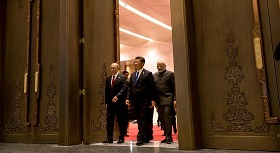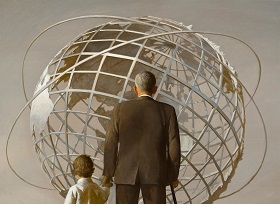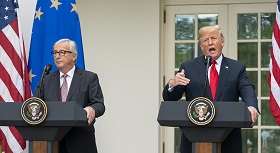The second cycle of BRICS summits has come to an end: the first full cycle for all five states and the tenth anniversary summit for the organization. It is time for some stock-taking. There is not much to say about the summit itself. It probably turned out to be too run-of-the-mill for an anniversary event. To no surprise, many commenters noted that the bilateral meetings held between leaders were richer in content than the group discourse.
BRICS attracted far greater positive attention than its rivals. This much was evident from the level of guests in attendance. In recent times, only the representatives of poor countries angling for aid from “the club of the rich” have attended the G7 summits with any kind of regularity. Conversely, the BRICS summit, in accordance with its combined nature, was attended by African states and major regional players, states that lead several international organizations.
BRICS attendees are growing more interested in systematic and full-fledged collaboration. Recep Erdogan’s speech was particularly memorable this year, as he called for the letter T to be added to the BRICS acronym. Although it is clear that, thus far, expansion could bring more problems than advantages, the summit also demonstrated that BRICS members need to make difficult decisions today.
The second cycle of BRICS summits has come to an end: the first full cycle for all five states and the tenth anniversary summit for the organization. It is time for some stock-taking.
A Hero on the Stage of another Theatre
It would seem that the true hero of the BRICS Summit was someone who is not even a member of the group. We are talking, of course, about President of the United States Donald Trump. Neither did he represent an invited member state either within BRICS Outreach or BRICS-plus. Indeed, he was not even physically present there. Yet it was Trump who helped transform a fairly regular and run-of-the-mill summit into a significant event even before it actually took place. The success of the BRICS Summit was helped by the G7 meeting and NATO summit that preceded it.
First, major scandals and the effective public failure of the meetings of western leaders have already shined a favourable light on the peaceful tone and aligned discourse of the leaders of the alternative “club,” even if they did not have a profound meaning. Second, the consistency with which Trump is keeping his campaign promises has shown the BRICS leaders that no one will be able to “sit it out.” Yes, the meeting between the leaders of the United States and China was a success, but this did not prevent Washington from then starting a trade war with its principal rival. No matter how much Washington may be courting India seen as a main counterbalance to China in the new political and geographical setup in the Indo-Pacific, the stance of the President of the United States on protecting U.S. manufacturers while essentially ignoring WTO rules, coupled with the fact that the two countries previously held very different positions, does not afford the Indian Prime Minister of India the luxury of becoming complacent and assume that the United States need for India will make it possible for New Delhi to continue to receive an endless supply of “carrots” from Washington unless India has additional insurance and an alternative counterbalance.
For Russia, the current situation is interesting in that now the other “club” members, and not Russia alone, need to protect themselves, and this gives BRICS a new impetus. Now all the BRICS countries are aware of their vulnerability, which is not only theoretical, but quite real. And this awareness, in turn, determines a far greater desire to come to an agreement, not just to politely support Russia by speaking about the inadmissibility of unilateral actions and sanctions that bypass the United Nations.
A Play Without a Hero
There is not much to say much about the summit itself. It probably turned out to be too run-of-the-mill for an anniversary event. Unsurprisingly, many commenters noted that the bilateral meetings held between leaders were richer in content than the group discourse. To be sure, it was hard to expect anything else from the organization’s weakest member, which is still experiencing problems stemming from the political processes taking place in the country. The general outline of the summit was quite standard. The key issues were inclusive and sustainable development, “the fourth industrial revolution,” and Africa’s special role in the context of South Africa’s claim to leadership on the continent. On the other hand, each party received some working mechanisms and initiatives that they surely found interesting. We are talking here about peacekeeping in Africa and around the world; a research platform for the energy sector or agriculture; joint research into distributed ledgers and blockchain; agreements on civil aviation or environmental issues; and opening a new regional office of the BRICS Development Bank in the Western Hemisphere.
Quite predictably, a great amount of space in the final document was given not only to issues of Africa, but also to the issues of the WTO, ranging from general promises to promote a “transparent, non-discriminatory, open and inclusive multilateral trading system” to barbs intended for the President of the United States on specific issues, such as the refusal to approve new members of the Appellate Body of the World Trade Organization. The already “mature” BRICS format entails not only active discussions of economic issues, but also gives significant attention to politics and security. However, there is nothing new in this, since despite the economic subtext that dominated the initial summits, political issues remain one of the pillars of cooperation for the members. It was interesting to note that the agenda featured a large number of items related precisely to security issues in the countries of the Middle East, as well as a very detailed paragraph on Syria (including support for the Sochi meeting and the Astana process in general, which looks like another jab directed at the United States due to its decreased level of representation and subsequent absence from the last meeting). The stance on the Korean settlement was sketched out very briefly, apparently because none of the BRICS countries feel like a leader in the process. The paragraph on preventing militarization of outer space did not contain references to the Russia-China initiative.
The initiatives discussed not only in the Business Club, but also at the BRICS Expert Council are gradually moving to the fore. Those are, in particular, issues pertaining to people-to-people contacts and humanitarian ties: holding joint events in cinema, education, culture, tourism and sport. The last section of the final declaration on “people-to-people” cooperation raised some eyebrows and the question of what the five leaders mean by such cooperation. This section lists various measures and steps to boost such contacts, but it also contains information that seems to be unrelated to this segment, such as the World Health Organization’s Global Ministerial Conference on Ending Tuberculosis held in Moscow, the World Water Forum in Brazil, the Vaccine Research and Development Center and matters related to outer space – that is, everything that was not listed in the previous sections. Does this speak to the lower priority the five leaders give to this aspect of cooperation? Or is it another example of the somewhat loose organization of this year’s summit?
Still, BRICS attracted far greater positive attention than its rivals. This much was evident from the level of guests in attendance. In recent times, only the representatives of poor countries angling for aid from “the club of the rich” have attended the G7 summits with any kind of regularity. Conversely, the BRICS summit, in accordance with its combined nature, was attended by African states and major regional players, states that lead several international organizations.
Unlike the G7 members, BRICS attendees are more and more interested in systematic and full-fledged collaboration. Recep Erdogan’s speech was particularly memorable this year, as he called for the letter T to be added to the BRICS acronym. Although it is clear that, thus far, expansion could bring more problems than advantages, and, as the President of the Russian Federation said, such questions are not decided “on the spur of the moment,” the summit also demonstrated that BRICS members need to make difficult decisions today. Talks about potential new candidates (Turkey, Argentina and Indonesia) can be held until these candidates begin to give very serious consideration to the prospects of such changes. The excessive delay in the process entails the risk that the former “circle of friends” of BRICS could turn their backs on it and start to consider alternative options of participating in global governance. So maybe it is finally time to think about real changes and innovations in the format and contents of the work of BRICS, be it various forms of institutionalization, admitting new members, or changing the format or types of cooperation.
When a Blast from the Past is not Really that Outdated
The world today is characterized not only by chronic turbulence, but also, despite its significantly more complex worldview, by the return of the key actors to geopolitics and the prioritizing of national interests. At the same time, given the new conditions, old tools and methods are no longer effective enough. Such a situation already arose in the early 1970s: a host of new challenges emerged; old institutions stopped being efficient; and capitalist powers needed to invest intellectual capital in determining further steps and inventing new approaches. It is during times like this that new formats of international collaboration appear in the form of international regimes and international “clubs.” Work within the G7 brought the stances of the leaders of the capitalist world closer together, helped overcome an identity crisis and ultimately resulted in a more profitable position by the end of the Cold War.
Methodologically, BRICS is analogous to the tried and tested G7 mechanism that was created 40 years ago. In this respect, it is hard to speak about innovations. This is why, when people speak about ineffectiveness of the models for regulating international relations, it also applies to the young BRICS mechanism borrowed from the past.
However, what makes the old model from the “G7 designer” somewhat more viable is the fact that members of the organization have far fewer things in common. This might sound illogical and go against the currently fashionable statements of some Russian and foreign experts that it is rather a major drawback for the club.
So, what is the source of such conclusions? Why would countries that have nothing in common do anything together? And how might they preserve long-term relations once the fleeting problems that brought them together are gone? What could five economies have to talk about if one of them is already the global leader in terms of GDP at Purchasing Power Parity, yet their mutual trade turnover, having increased by “as much as 30 per cent,” totals just $102 billion? What do authoritarian and democratic regimes have in common, especially when participants love to differentiate themselves along these lines? And this list of questions is by no means exhaustive.
Moreover, the principle of “becoming friends solely to stand against” somebody that has been repeatedly stressed this year is always unstable and easily shattered by concessions from the party against which it is intended. The problem, however, is that if Trump’s policies (in particular, launching the current trade war) have created a starker background for collaboration (and the BRICS president’s rating has recently dropped to junk, thus prompting the idea of the organization establishing a rating agency of its own), it is still only a background. Probably, given the considerable contradictions in India–China relations, India is indeed the relatively “weak” link in BRICS. This applies not only to unresolved territorial disputes, but also to its strategic resistance to Beijing’s Belt and Road initiative, as well as other issues. Of course, the United States plays the Indian card in its rivalry with China with varying degrees of success. It is not for nothing that, intentionally or not, the ending of the BRICS summit coincided with the announcement that India now is one of the United States’ privileged allies; moreover, hi-tech weapons can now be sold to India. What was it – a general demonstration of support for India, or compensation for the CAATSA, rather than an anti-Chinese step? Another attempt to force Russia out of this market segment? Whatever it was, any such attempts to pitch one BRICS country against the others through the concessions of the United Stated do not provide sufficient grounds to disband the BRICS mechanism.
They have something far more fundamental in common: as a result of a particular historical situation, western countries have attempted to consider each BRICS country not as an independent actor in the global politics, but as an object that can be influenced and which must be either incorporated into the liberal democratic system on the system’s terms or (if the country resists) to be pushed outside the “global community” as far as possible and be isolated. The G7 itself transformed into a project of “friendship against” the USSR, the socialist camp and the newly independent developing countries. Each BRICS member began to demonstrate too much independence and a vision different from the one commonly accepted in the West. Or their capabilities grew. Or they were not considered equals as a matter of principle. Hence the common principles of protecting sovereignty, the unacceptability of interference in the internal affairs of another state, the unacceptability of unilateral pressure and the reliance on multipolarity, as well as the strong emphasis on the role of the United Nations.
We should not forget that BRICS membership is a status – the status of a global power even for regional actors that do not quite qualify for that status under other criteria. Given the maximum vulnerability of the states against the background of current global turbulence, BRICS means common insurance.
Other commonalities emerge in the course of business and create that untearable network of collaboration on various levels that allows the organization and its members to live their lives regardless of the weaknesses or strengths of a particular president, or the successes or failures of a particular meeting. The starker and longer the strategic disrespect and resistance to alternative visions of BRICS countries and other non-western states, the desire to “divide and rule” – the stronger the BRICS network is and the higher the chances that when the time comes for the network to spread wider, it will not “wash out” and its thread will not weaken. Because it is not a project of “friendship against” anybody, it is a partnership for a common future of independent, integral, full-fledged subjects of a stable and prosperous system of international relations.







